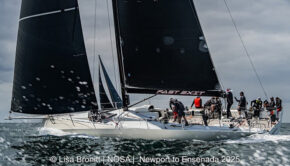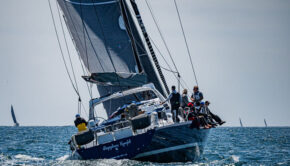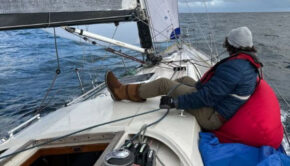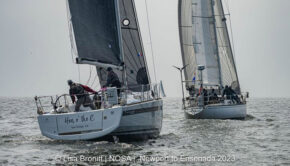202 entrants for Ensenada Race
Published on April 25th, 2013
The 202 entries were boggling their minds about how to sail the Lexus Newport to Ensenada Yacht Race starting Friday (April 26, 2013) off the Balboa Pier in Newport Beach, CA.
How complex can that be? It’s a 125-nautical mile course down the Pacific Coast to a lively Mexican resort in Baja California, and some of the world’s best sailors have been doing it over the last 65 years.
And many of them still haven’t figured it out. The wind is a riddle, light or strong, off the sea or off the land, from ahead or behind, and changing along the way.
That’s why Tom Holthus has had his buddy Scott Lowry on board his Bad Pak boats through more than a decade of successful offshore racing. That included last year’s race when they were first to finish one of the most taxing N2Es of all, gasping across the line off the Hotel Coral race headquarters in virtually no wind after 19 hours 48 minutes 19 seconds—more than nine hours slower than the record of 10:37:50 set by Doug Baker’s Magnitude 80 in 2009.
Whatever, Bad Pak made the best of it, which is what the better boats do.
“I’ve been Tom’s navigator—or naviguesser—for eight years now,” Lowry said.
Class starts will be at 10-minute intervals beginning at 11 a.m. The Cruising classes start first, with a new rule that autopilots and steering vanes shall not be used while engines are on and engaged. Racing class starts will begin at noon. Boats finishing after 11 a.m. Sunday will not be scored.
The major prize is the President of USA Trophy for the overall winner on corrected handicap time, won last year by Medicine Man, which finished only 12 minutes 6 seconds behind Bad Pak but had a better handicap rating. Lane also collected a free two-year lease on a sports car from Lexus, which is offering a 2014 IS F Sport this year.
Also, the Cruising class winner on corrected time will receive a four-day three-night vacation stay at the Coral Hotel.
With Lowry and a core crew of about a dozen longtime pals, Holthus, a San Diego Yacht Club member, also sailed a J/145 Bad Pak to Div. 4 wins in the last two Transpacific Yacht Races, where he will take on the Maxis this summer. His new Bad Pak, an STP 65, was formerly Jim Swartz’s Moneypenny, a Reichel/Pugh design launched in Australia in 2008.
With GPS, modern weather technology and satellite tracking, sailboat racing isn’t the same as the good old days. Nowadays one always knows where the enemy is.
“It certainly changes the game,” Lowry said. “I wouldn’t say it makes it any easier. Some of the slower boats in the past have had a chance to make a move in the darkness. With the tracker that’s changed. I’m not saying it’s not better or worse but different. Once you’ve made your bed you kind of have to sleep in it.”
For Magnitude 80 in 2009, it didn’t matter. With a strong following wind all the way to the finish, Baker said later, “We did one tack and one jibe in the whole race.”
Dream on, N2E racers.
“The Ensenada race, you do the same thing we do every time, like everyone else,” Lowry said. “Watch the weather day by day, hour by hour. There are a few regular patterns that occur and you’re just hoping to identify which one of them is going to be the one.”
There are three critical calls: continue out to sea for better wind after the start or turn down the coast on the shorter, more direct rhumb line; later, go inside or outside the Coronado Islands past the international border (inside with offshore wind, outside with onshore wind); finally, enter Todos Santos Bay at first opportunity or wait for a better wind angle.
“For us,” Lowry said, “we don’t really make any decisions until the hours leading up to the race. Anything outside of five days is interesting but not reliable. The weather forecasts these days do a phenomenal job, and we heavily rely on them, but once you get down into 48 hours you kind of know what the big picture is going to be.”
One late decision will be about how many crew to carry—10 to 18—depending on the anticipated wind strength.
And, Lowry notes, some would prefer not to have the ideal conditions Magnitude 80 had in 2009 because “when you take any kind of tactical advantage out of a race, it becomes a drag race. In many cases, the old school rules of thumb are deterred by the modern technology, but you never throw them out.
“Our plan is to be vigilant and watch the conditions and, based on the forecast and the experience of the crew and the gut to what we think is going to happen.”
Meanwhile, the large multihulls Loe Real and Afterburner will be back, stalking the virtually untouchable multihull record of 6 hours 46 minutes 40 seconds set in 1998 by the late Steve Fossett on the 60-foot Stars & Stripes catamaran—the only boat ever to finish before sundown on the same day it started.
MEDIA CONTACT
Rich Roberts
Press officer







 We’ll keep your information safe.
We’ll keep your information safe.